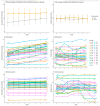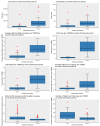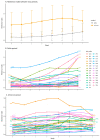Comparison of COVID-19 Resilience Index and Its Associated Factors across 29 Countries during the Delta and Omicron Variant Periods
- PMID: 35746548
- PMCID: PMC9228202
- DOI: 10.3390/vaccines10060940
Comparison of COVID-19 Resilience Index and Its Associated Factors across 29 Countries during the Delta and Omicron Variant Periods
Abstract
Our study aims to compare the pandemic resilience index and explore the associated factors during the Delta and Omicron variant periods. In addition, the study aims to identify the characteristics of countries that had good performances. We analyzed observation data among 29 countries over the first eight weeks during the two periods of Delta and Omicron variant dominance. Data were extracted from open public databases. The Omicron variant caused a lowered mortality rate per 100,000 COVID-19 patients; however, it is still imposing a colossal burden on health care systems. We found the percentage of the population fully vaccinated and high government indices were significantly associated with a better resilience index in both the Delta and Omicron periods. In contrast, the higher death rate of cancers and greater years lived with disability (YLD) caused by low bone density were linked with poor resilience index in the Omicron periods. Over two periods of Delta and Omicron, countries with good performance had a lower death rate from chronic diseases and lower YLD caused by nutrition deficiency and PM2.5. Our findings suggest that governments need to keep enhancing the vaccine coverage rates, developing interventions for populations with chronic diseases and nutrition deficiency to mitigate COVID-19 impacts on these targeted vulnerable cohorts.
Keywords: COVID-19; Delta; NPIs; Omicron; vaccine; variants.
Conflict of interest statement
The authors declare no conflict of interest.
Figures





Similar articles
-
A global analysis of COVID-19 infection fatality rate and its associated factors during the Delta and Omicron variant periods: an ecological study.Front Public Health. 2023 Jun 2;11:1145138. doi: 10.3389/fpubh.2023.1145138. eCollection 2023. Front Public Health. 2023. PMID: 37333556 Free PMC article.
-
Clinical Characteristics and Outcomes Among Adults Hospitalized with Laboratory-Confirmed SARS-CoV-2 Infection During Periods of B.1.617.2 (Delta) and B.1.1.529 (Omicron) Variant Predominance - One Hospital, California, July 15-September 23, 2021, and December 21, 2021-January 27, 2022.MMWR Morb Mortal Wkly Rep. 2022 Feb 11;71(6):217-223. doi: 10.15585/mmwr.mm7106e2. MMWR Morb Mortal Wkly Rep. 2022. PMID: 35143466 Free PMC article.
-
Waning 2-Dose and 3-Dose Effectiveness of mRNA Vaccines Against COVID-19-Associated Emergency Department and Urgent Care Encounters and Hospitalizations Among Adults During Periods of Delta and Omicron Variant Predominance - VISION Network, 10 States, August 2021-January 2022.MMWR Morb Mortal Wkly Rep. 2022 Feb 18;71(7):255-263. doi: 10.15585/mmwr.mm7107e2. MMWR Morb Mortal Wkly Rep. 2022. PMID: 35176007 Free PMC article.
-
COVID-19 Variants in Critically Ill Patients: A Comparison of the Delta and Omicron Variant Profiles.Infect Dis Rep. 2022 Jun 17;14(3):492-500. doi: 10.3390/idr14030052. Infect Dis Rep. 2022. PMID: 35735762 Free PMC article.
-
Comparison of Omicron and Delta Variant Infection COVID-19 Cases - Guangdong Province, China, 2022.China CDC Wkly. 2022 May 6;4(18):385-388. doi: 10.46234/ccdcw2022.087. China CDC Wkly. 2022. PMID: 35686204 Free PMC article.
Cited by
-
Association of Digital Health Literacy with Future Anxiety as Mediated by Information Satisfaction and Fear of COVID-19: A Pathway Analysis among Taiwanese Students.Int J Environ Res Public Health. 2022 Nov 24;19(23):15617. doi: 10.3390/ijerph192315617. Int J Environ Res Public Health. 2022. PMID: 36497691 Free PMC article.
References
-
- Patel M.D., Rosenstrom E., Ivy J.S., Mayorga M.E., Keskinocak P., Boyce R.M., Hassmiller Lich K., Smith R.L., III, Johnson K.T., Delamater P.L., et al. Association of Simulated COVID-19 Vaccination and Nonpharmaceutical Interventions with Infections, Hospitalizations, and Mortality. JAMA Netw. Open. 2021;4:e2110782. doi: 10.1001/jamanetworkopen.2021.10782. - DOI - PMC - PubMed
-
- Johns Hopkins Coronavirus Resource Center Pandemic Data Initiative. [(accessed on 19 May 2021)]. Available online: https://coronavirus.jhu.edu/pandemic-data-initiative.
-
- Lin T.-Y., Liao S.-H., Lai C.-C., Paci E., Chuang S.-Y. Effectiveness of Non-Pharmaceutical Interventions and Vaccine for Containing the Spread of COVID-19: Three Illustrations before and after Vaccination Periods. J. Formos. Med. Assoc. 2021;120((Suppl. 1)):S46–S56. doi: 10.1016/j.jfma.2021.05.015. - DOI - PMC - PubMed
LinkOut - more resources
Full Text Sources

